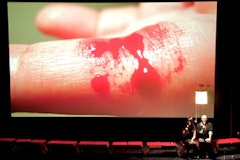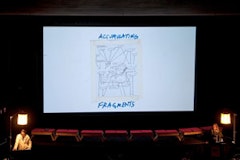Local
UnionDocs Brings Auteurs Together
Tina Antolini has a thing for words. When she speaks, she savors them. As a producer for National Public Radio, words are her business. But sometimes, they are her subjects.

I’ve been obsessed with language for a long time,” said Antolini in a phone interview. “Every time someone says a phrase, I’ll end up having a conversation about where the heck it came from.”
On stage in front of 400 people in a dark theater at the New York MoMA in late February, Antolini took up the origin of one word in particular—“whatever”.
Antolini’s audio and live performance was one of six pieces that the members of the UnionDocs Collaborative debuted at Documentary Fortnight, the museum’s annual festival of non-fiction film. The pieces were experimental, but it was fitting, because the Collaborative too is an experiment started this year by the Brooklyn non-profit UnionDocs.
Somewhere between an informal critique group and a graduate program, Collaborative members trade a one-year commitment and $3,000 for two mentors, masters classes, and most importantly, access to like-minded people from many different disciplines.
For Rahul Chadha, an aspiring filmmaker with a background in journalism, shooting video and talking theory with radio producers, filmmakers, critics, and architects is a brave new world, the kind he hoped for when he signed on for the program.
“What they do really inspires me,” said Chadha. “I’m getting exposed to all of these different modes of storytelling.”
The project is part of a do-it-yourself approach to pedagogy cropping up in design and art communities from California to Toronto. The goal at UnionDocs isn’t to dream up buildings or lay down paint, but to think about what it means to tell true stories, and how to document them.
The idea for the program sprouted from the possibilities, and problems, of documentary today. “It’s very clear that anyone can create and present the way that they think the world is,” said Jesse Shapins, Co-Mentor for the Collaborative, “and people will believe it.” The group tries to rub up against that belief, asking questions about truth rather than swallowing it whole.

The 11 members devote evenings and weekends to reading Roland Barthes and deconstructing documentaries on Lil Wayne, scoping the many ways that their predecessors have told nonfiction stories on film. In between, they work on a yearlong project, a group documentary meant, at its most ambitious, to question the premises and problems behind the “myth” that documentary is necessarily synonymous with truth.
Founded in 2002, UnionDocs is one of several micro-cinemas and roving film series in Brooklyn that are making room to see and discuss documentaries. Unlike the works of Michael Moore, or the sprawling epics of Ken Burns, most docs are made on shoestring budgets and are never slated for wide distribution.
Since the beginning, the core group at UnionDocs has been interested in discussing and making work as much as showing it. Over the years Christopher Allen, Jesse Shapins, Johanna Linsley, Paul Kiel, and Kara Oehler began to collaborate to make “documentaries” that played with the possibilities of the term.
“We are looking at what representing the real is, right now, in contemporary life,” explained Allen, Executive Director of UnionDocs.
The filmmakers are less interested in presenting a point of view than in looking at the problems inherent in doing so. For example, they shot a film that probed the popularity of currywurst, Germany’s beloved sausage-plus-sauce. And they “acquired,” displayed, and buried with due mock-gravitas a pay phone from down the street, a relic of a pre-cell phone past.
Behind the cheeky pieces lay serious inquiry about how to try to capture a contemporary moment. What, thought Allen, if UnionDocs created a formal structure for those questions? Would it be possible to bring together a group of strangers to work together in a similar way? From these questions, the Collaborative was born.
On a Sunday evening in early February, the group gathered at its headquarters on Union Avenue in Williamsburg for its weekly critique session. The room filled with chatter. Strangers six months ago, the young, enthusiastic group talked easily about theory, film, and last week’s lunch. A few spoke with the young filmmakers from Finland who were there to sit in on the session.
The room buzzed with excitement, and anxiety, about the Collaborative’s upcoming presentation of the “Myth Project” at the MoMA’s Documentary Fortnight.
The “Myth Project” is heady. The six pieces spring from the reading and analysis of Roland Barthes’ Mythologies, the theorist’s 1957 book of essays exploring everyday myths from red wine (the “totem drink” of France) to toys. Then they created six pieces that looked at their own interpretations of modern-day mythologies.
Jolene Pinder and Josh Solondz, whose film was the first to flicker across the retractable screen, chose the “myth” of the tabletop fountain.
Thousands of the electronic gurgling water fountains sell each year, often as wedding gifts, Pinder’s voice tells us in the opening sequence of the short film. For $19.99 and up, the little waterfalls promise to soothe the modern soul.
In the main scene, a curly haired woman perches awkwardly in a chair in her home office, a stone pyramid peacefully circulating water beside her. “This is my fountain, my little fountain,” she says. “She keeps me company when I’m working.”
They ask the woman to explain why she is so tied to her fountain, and she can’t exactly. “It isn’t nature,” she says, “It wouldn’t help me get closer to nature.”
She squirms a little, the trickle of water filling the silence. “I could get an iPhone app with the sounds of waves,” she says. She’s not sure why she hasn’t. It just seems like it wouldn’t be the same.
In the critique afterward, Finnish filmmaker Kanerva Cederström offered her perspective on the piece. “The woman herself deconstructed this myth,” she said. “At first she was your object. Then she began to think.”
Each piece in the Collaborative used an “object” to examine the idea behind it. Rahul Chadha and Robbie Wilkins used Facebook to talk about friendship. Andre Almeida and Will Martin culled archival footage and YouTube clips to explore our relationship to nature. Shawn Wen and Hyatt Michaels toyed with hair to think on beauty, and Katia Maguire and Ben Brown paired a politician’s rant with a shot of a slow subway train to unpack the metaphor of “the third rail.”
One member—the odd 11th—worked alone. Tina Antolini’s myth examined language by delving into the etymology of a word so common it has become a reflex—“whatever”.
Through weeks of regular, sometimes grueling, group critiques, she had formed a radio-style piece she would perform live at the MoMA. The massive edits can be a struggle—everyone’s a critic, and the critics come from film, radio, theory, architecture, and journalism. But for Antolini, those same perspectives make the process worthwhile.

“Hanging out with a bunch of filmmakers is a completely new experience for me as a radio producer,” she said. “I’ve started thinking about things visually, which brings a new dynamism to a sound piece. I don’t feel now I have to limit things just to sound.”
Two weeks later in the bowels of the MoMA, plush red chairs sunk below the audience of hundreds in the darkened theater. A voice filled the room.
“Tina, do you know how language is created?”
Antolini took the stage, long legs clad in brown leather boots. Clipboard in hand, she began her answer.
Over the speakers tumbled a cacophony of voices: “whatever,” “what-ever,” “whatevs”. Antolini, clipboard in hand, stood spotlighted on stage, rich voice dipping and skating over vowels to weave recordings together. Scraps of interviews surfaced. Cher Horowitz’s voice from the 90s Valley Girl classic Clueless rang out. Then the voice of Jesse Sheidlower, North American Editor-at-Large of the Oxford English Dictionary, cut to the heart of the matter:
The first appearance of ‘whatever’ in print comes from a Department of Defense Handbook provided to prisoners of war returning from Vietnam, said Sheidlower. It was defined, for the uninitiated, as ‘that’s what I meant’.
Antolini’s mash-up of radio and performance was an experiment. Each voice was a single vision, which Antolini then assembled in order to tackle a greater truth.
The same process is at the heart of the UnionDocs Collaborative. No one knew exactly what a bunch of strangers, A/V equipment, and time would bring, but it has worked out better than any of them had anticipated.
“What’s happening now is that we are lacing expectations into what we do,” said member Robbie Wilkins. “And we’re trying to figure out what’s next.”
Notes
¯¯¯¯¯¯¯¯¯¯¯¯
For more about UnionDocs, go to www.uniondocs.org.

